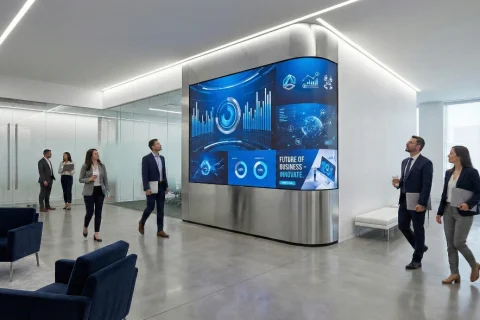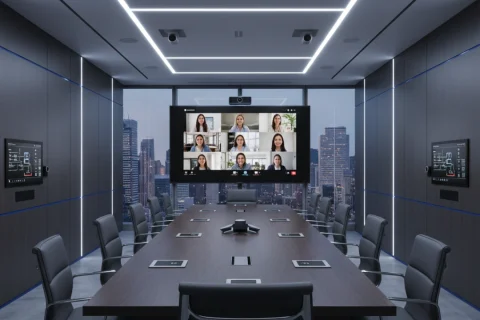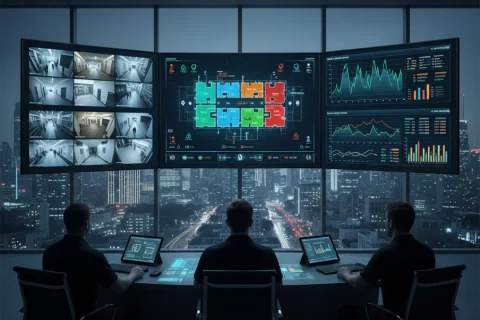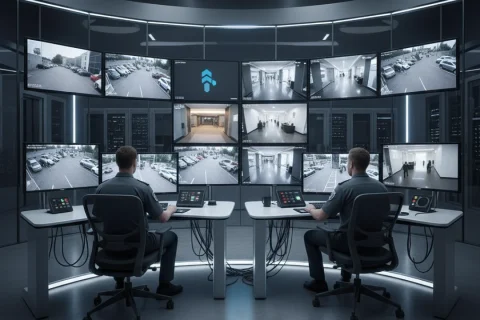Introduction
In today’s fast-paced digital landscape, businesses need innovative ways to capture attention and communicate effectively. A digital signage solution offers a dynamic platform to deliver real-time content, engage audiences, and enhance brand visibility across multiple touchpoints. Whether you’re managing a retail store, corporate office, or public infrastructure, digital signage transforms static messaging into interactive experiences that drive results. This comprehensive guide explores how modern digital signage systems work, their key benefits, and how to choose the right solution for your business needs.
Key Takeaways
- Digital signage solutions enable real-time content delivery and enhanced customer engagement across various industries
- Advanced digital signage content management systems provide centralized control over multiple displays and locations
- Integrating digital signage with IoT and smart infrastructure creates seamless, data-driven communication networks
- Strategic implementation of digital displays can increase sales, improve operational efficiency, and strengthen brand presence
What is a Digital Signage Solution?
A digital signage solution is an integrated system that combines display hardware, content management software, and network connectivity to deliver dynamic visual content to target audiences.
Modern digital signage solutions go beyond simple screen displays. They incorporate advanced technologies like cloud-based management, artificial intelligence, and real-time data integration to create personalized viewer experiences. From smart ELV systems to standalone displays, these solutions adapt to various business environments. The core components include display screens (LED, LCD, or projection systems), media players, content management platforms, and network infrastructure. Organizations across retail, healthcare, education, and corporate sectors leverage digital signage to communicate more effectively with employees, customers, and visitors while reducing printing costs and environmental impact.
Core Benefits of Implementing Digital Signage
Digital signage delivers measurable ROI through increased engagement, operational efficiency, and enhanced brand visibility across all customer touchpoints.
Research shows that digital displays capture 400% more views than static signage, directly translating to improved customer engagement and sales conversion rates. Businesses implementing digital signage report up to 33% increase in sales due to targeted promotions and dynamic content delivery. Beyond marketing, digital signage streamlines internal communications, reduces perceived wait times in service environments, and provides valuable analytics on viewer engagement. The flexibility to update content instantly across multiple locations eliminates printing costs and enables rapid response to market changes. Additionally, integrating digital signage with IoT solutions creates intelligent environments where displays respond to real-time data such as weather, inventory levels, or foot traffic patterns, maximizing relevance and impact.
Key Features of a Digital Signage Content Management System
Modern content management systems provide intuitive interfaces, multi-user collaboration, scheduling capabilities, and real-time performance analytics for optimal display management.
A robust digital signage content management system serves as the control center for your entire display network. Essential features include:
- Cloud-Based Access: Manage content from anywhere, enabling distributed teams to collaborate seamlessly
- Content Scheduling: Program specific messages for different times, days, or triggered events
- Multi-Screen Management: Control hundreds of displays across various locations from a single dashboard
- Template Libraries: Pre-designed layouts accelerate content creation while maintaining brand consistency
- User Permissions: Role-based access ensures content security and workflow efficiency
- Analytics Dashboard: Track viewer engagement, content performance, and system health metrics
- Emergency Override: Instant broadcast capability for critical communications or alerts
- Integration APIs: Connect with existing business systems like POS, CRM, or social media platforms
Advanced systems also offer AI-powered content recommendations, automated playlist generation based on audience demographics, and real-time content adaptation. When selecting a platform, prioritize scalability, ease of use, and comprehensive technical support to ensure long-term success.
Industry Applications of Digital Signage Solutions
Digital signage transforms operations across retail, corporate, healthcare, education, and hospitality sectors with tailored communication strategies.
Retail Environments: Dynamic product displays, promotional content, and interactive kiosks drive impulse purchases and enhance shopping experiences. Digital menu boards in quick-service restaurants can increase sales by up to 5% while reducing perceived wait times by 35%.
Corporate Offices: Internal communications, wayfinding, room booking displays, and employee recognition programs improve workplace efficiency and culture. Integration with manufacturing operations enables real-time production dashboards and safety messaging.
Healthcare Facilities: Patient information systems, wayfinding for complex buildings, health education content, and queue management reduce anxiety and improve patient experience.
Education Institutions: Campus announcements, emergency alerts, event promotion, and interactive learning displays create connected learning environments.
Transportation Hubs: Real-time travel information, advertising, wayfinding, and emergency communications serve thousands of travelers efficiently.
The versatility of digital signage makes it valuable for virtually any industry seeking to modernize communications and enhance stakeholder engagement.
Integrating Digital Signage with Smart Infrastructure
Seamless integration with ELV systems, IoT devices, and building management platforms creates intelligent, responsive environments that optimize operations and user experiences.
The true power of digital signage emerges when integrated into comprehensive smart infrastructure ecosystems. By connecting displays with sensors, cameras, and building management systems, organizations create responsive environments that adapt to real-time conditions. For example, digital signage in retail environments can automatically adjust promotions based on inventory levels detected through RFID systems, or display weather-appropriate product recommendations based on local conditions.
Integration with access control systems enables personalized greetings and wayfinding for VIP visitors, while connection to occupancy sensors allows meeting room displays to show accurate availability. In smart buildings, digital signage becomes part of the emergency response system, automatically displaying evacuation routes and safety information when security systems detect threats. This interconnected approach, facilitated by advanced software solutions, maximizes the value of every technology investment while creating seamless user experiences that would be impossible with isolated systems.
Choosing the Right Digital Signage Provider
Selecting a provider with proven expertise, comprehensive support, and scalable solutions ensures long-term success and maximum return on investment.
When evaluating digital signage providers, consider these critical factors:
Technical Expertise: Look for providers with demonstrated experience in your industry and use case. Review case studies, client testimonials, and technical certifications.
Solution Scalability: Ensure the system can grow with your business, from a single display to enterprise-wide deployments across multiple locations.
Integration Capabilities: Verify compatibility with your existing IT infrastructure, software systems, and future technology roadmap.
Content Support: Assess whether the provider offers content creation services, training, or ongoing creative support beyond just hardware and software.
Service and Maintenance: Understand the support model, response times, warranty terms, and availability of local technical resources.
Total Cost of Ownership: Consider not just initial hardware costs but ongoing licensing, content creation, maintenance, and potential upgrade expenses.
With over 10 years of experience delivering smart infrastructure solutions, Vega Digital IT Solutions provides end-to-end digital signage implementation tailored to your specific business objectives and technical requirements.
Best Practices for Digital Signage Content
Effective content combines clear messaging, appropriate dwell time, visual hierarchy, and regular updates to maintain viewer engagement and achieve communication goals.
Creating compelling digital signage content requires understanding your audience and environment:
- Keep It Simple: Limit text to 5-7 words for high-traffic areas where viewing time is brief
- Visual Dominance: Use high-quality images or video that support your message, with text as secondary element
- Contrast and Readability: Ensure sufficient color contrast for visibility from various distances and lighting conditions
- Appropriate Duration: Display static content for 5-10 seconds; videos should not exceed 15-30 seconds for maximum retention
- Call to Action: Include clear next steps whether directing to websites, locations, or specific behaviors
- Content Refresh: Update content regularly (weekly or bi-weekly) to maintain interest and relevance
- Test and Optimize: Use analytics to identify best-performing content and continuously refine your approach
Professional content design accelerates time-to-value and ensures your digital signage investment delivers measurable results from day one.
Measuring Digital Signage ROI
Quantifiable metrics including engagement rates, sales lift, operational savings, and customer satisfaction provide clear evidence of digital signage value.
Successful digital signage implementations track specific KPIs aligned with business objectives. For retail applications, measure sales conversion rates, average transaction value, and product-specific lift following promotional display. In corporate environments, assess employee satisfaction scores, message recall rates, and reduction in email communications. Transportation and public venues track dwell time, queue satisfaction, and information inquiry reduction.
Advanced systems with camera-based analytics (respecting privacy regulations) provide demographic data, attention measurement, and heat mapping to optimize content placement and timing. Calculate total cost savings from eliminated print materials, reduced labor for manual sign updates, and decreased customer service inquiries. When properly measured, digital signage typically achieves full ROI within 12-18 months while delivering ongoing operational benefits.
Conclusion
Digital signage solutions represent a strategic investment that transforms how businesses communicate, engage audiences, and operate efficiently. By implementing a comprehensive digital signage content management system integrated with your smart infrastructure, you create dynamic environments that respond to real-time conditions while delivering personalized, relevant content to every viewer. Whether you’re enhancing customer experiences in retail, streamlining corporate communications, or modernizing public spaces, digital signage provides the flexibility, scalability, and measurable results that drive business success.
Ready to transform your business communication with cutting-edge digital signage technology? Contact Vega Digital IT Solutions today to explore customized solutions designed for your specific needs and industry requirements.
Frequently Asked Questions
What is a digital signage solution?
A digital signage solution is an integrated system combining display hardware, software, and network connectivity to deliver dynamic visual content. It enables businesses to communicate real-time messages, promotions, and information across multiple screens from a centralized platform, enhancing engagement and operational efficiency.
How does a digital signage content management system work?
A digital signage content management system provides cloud-based control over all displays, allowing users to create, schedule, and publish content remotely. It offers templates, multi-user access, analytics tracking, and integration capabilities with existing infrastructure systems for seamless operation across locations.
What are the main benefits of digital signage for businesses?
Digital signage increases customer engagement by 400%, drives sales through targeted messaging, reduces printing costs, and enables instant content updates. It improves brand visibility, streamlines internal communications, and provides valuable analytics on viewer behavior and content performance for data-driven decisions.
How much does a digital signage solution cost?
Digital signage costs vary based on display size, quantity, software features, and installation complexity, typically ranging from $1,000 to $10,000 per screen. Cloud-based content management systems charge monthly fees between $10-$50 per screen, with enterprise solutions offering customized pricing for large deployments.
Can digital signage integrate with existing business systems?
Yes, modern digital signage integrates seamlessly with POS systems, CRM platforms, social media feeds, and robotics automation solutions. API connectivity enables real-time data synchronization, allowing displays to show inventory levels, customer information, production metrics, and personalized content dynamically.
What industries benefit most from digital signage solutions?
Retail, healthcare, education, corporate offices, hospitality, and transportation sectors gain significant advantages from digital signage. Each industry leverages customized content strategies from promotional displays to wayfinding in hospitals and real-time updates in transportation hubs for improved customer experiences.
How do you measure digital signage ROI?
Track engagement metrics like dwell time, conversion rates, and sales lift in specific product categories. Monitor operational savings from reduced printing costs, decreased customer service inquiries, and improved employee communication efficiency. Advanced analytics provide demographic data and content performance insights for optimization.
What content performs best on digital signage displays?
High-quality visuals with minimal text (5-7 words), bold colors, and clear calls-to-action achieve highest engagement. Video content under 30 seconds, real-time data feeds, user-generated content, and personalized messages based on audience demographics consistently outperform static images.
Is cloud-based or on-premise digital signage better?
Cloud-based digital signage offers remote access, automatic updates, scalability, and lower upfront costs, making it ideal for multi-location businesses. On-premise solutions provide greater data control and work without internet dependency, suited for secure environments requiring enhanced security measures.
How long does digital signage implementation take?
Small deployments (1-5 screens) can be implemented within 1-2 weeks, while enterprise solutions spanning multiple locations require 4-8 weeks. Implementation timelines include hardware installation, network configuration, software setup, content creation, and staff training to ensure successful deployment and adoption.









